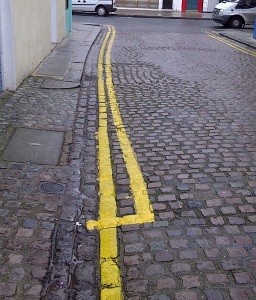Not a great photo so difficult to tell the whole story visually, but came across some badly painted double yellow lines this morning. Difficult not to read on, isn’t it?
Even though there was only a small diversion from their usual strictly uniform and parallel route, in that short distance the silent authority of the double yellows was lost and suddenly they became two uncoordinated marks, each with their own slightly all over the place personalities.
There is also a practical element to this breakdown in visual authority: my driving instructor used to tell me that when you park on double yellows that have been badly painted, if you take a photo of them, you will be let off any related parking fine. The argument goes that if they’re not as you expect them to be, then you can argue their meaning wasn’t clear to you.
From a different angle, a quick google search reveals some examples of how attractive the lines can look. There are two really nice examples from photographer Jess Hurd of yellow lines as decoration to unusually shaped bits of road.
